by Editor | Mar 26, 2012 | Attractions
Article and photos by Elena del Valle
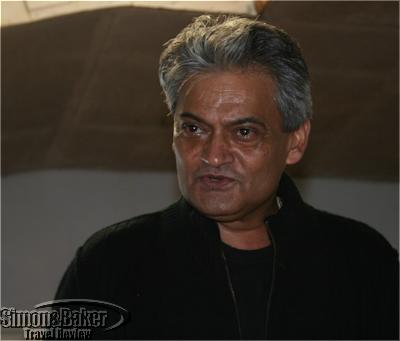
Swaraj Kumar Banerjee, the owner of the Makaibari Tea Estate
The highlight of our one night stay in northeastern India’s famed Darjeeling tea growing area was a tea tasting with Swaraj Kumar Banerjee, the owner of the Makaibari Tea Estate (Kurseong 734203, District Darjeeling, West Bengal, +00 91 33 22878560, fax +00 91 33 22870695, www.makaibari.com, slg_rajah@sancharnet.in). The estate, 573 hectares large with 250 hectares under tea and the remainder under forests, had a total population of 1,549 between newborn to 91 years of age including 656 workers. Makaibari means cornfield.
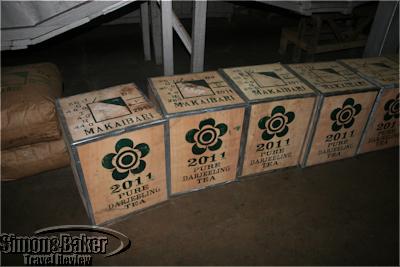
Tea for shipment
During our visit we had an opportunity to stroll in the organic tea plantation, meet some of the members of the community, visit the factory (because it was a national holiday it was closed), hear a presentation by Banerjee about the biodynamic principals used on the estate and sample some of the teas with his guidance. The Makaibari Estate produced six varieties of premium teas: Silver Tips Imperial, white tea, silver green, oolongs, first flush vintage and muscatel second flush.
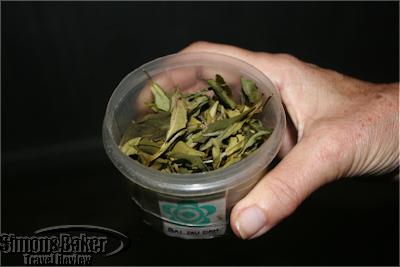
Makaibari tea leaves

Samples of tea
Although most of the tea production in the area, we were told, is in the hands of large producers and multinational companies, Makaibari remains a family owned affair in continuous operation since 1859. More importantly, for some, the estate owners today strive to set the standard for organic production and responsible tourism practices in the region.
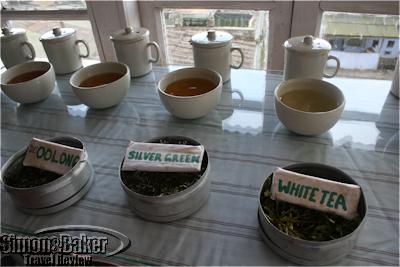
The tea tasting area
The tasting took place in an upstairs area adjacent to a conference room and the owner’s office. The tasting room, hot even before the first sip of tea, was filled with tea displays and memorabilia. We were each supplied with a spoon and instructed on how to taste the tea. The process included sipping a spoon full of tea, swirling the tea in our mouths and breathing through our mouths to enhance the flavor prior to spitting it out in a corner sink, one at a time. For each tea we completed this process while circling around the room toward a row of teacups set atop a shelf.
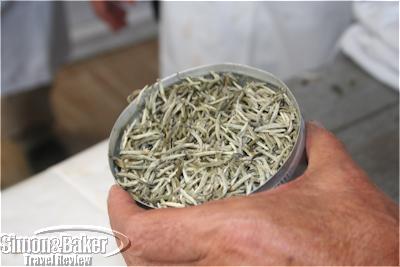
Silver Tips
Among the teas was the Silver Tips Imperial notable because it is collected under the full moon. Priced at $1,600 per kilo it is reputedly the most expensive tea in the world. This was the only tea in the tasting we swallowed rather than spitting it out in the sink. It was surprisingly subtle. At the conclusion of the tasting we were invited to a guided walk through the organic tea plantation.

A view of the Makaibari building from the road

Makaibari tea fields
Before departing I stopped at the tiny shop to buy two small bags to share and remember my experience. Now every time I have a cup it reminds me of the Makaibari Tea and Raja Banerjee, as the staff call him, the Raja of Darjeeling Organic Tea.
by Editor | Mar 19, 2012 | Accomodations, Restaurants and Food
Article and photos by Elena del Valle
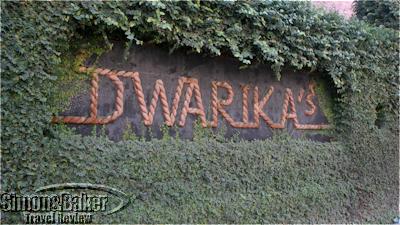
The entrance to Dwarikas
To reach Nepal from the United States east coast I traveled many hours with several stops along the way. When I arrived, the sweltering Kathmandu airport seemed chaotic and on exiting I, at first, missed my guide in the sea of unfamiliar faces. Narrow city streets shared by all manner of vehicles honking intermittently and livestock provided my first impression. I was excited to have secured accommodations at my first choice of the bustling city’s luxury hotels. For my arrival day the hotel had been fully booked until a last minute opening made it possible to secure a reservation for my entire stay in Kathmandu.
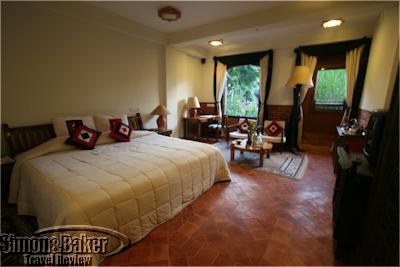
My first room had a view of the pool
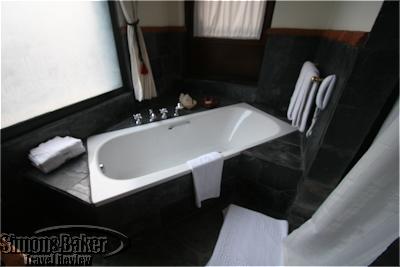
My bathtub at Dwarikas
In my sleep deprived and jet lagged state little enthusiasm to explore remained and I desperately wished for a clean and quiet place to call my own, at least for a few hours. That was not to be the case, at least not right away, as my room was not ready, literally. Workmen were putting the finishing touches on the newly constructed room (and building) assigned to me at Dwarika’s Hotel. One of the staff was kind enough to notice that I was tired and offered a temporary solution, a room where I could rest for 90 minutes until mine became available at 6 p.m.
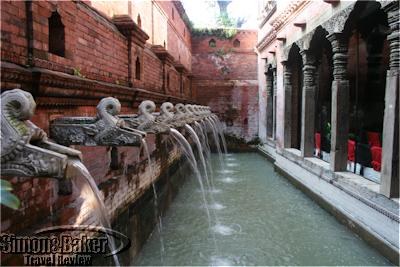
Fountains in a courtyard of the hotel
My rooms (I stayed at two rooms. At the staff’s suggestion I was relocated from my original room after the first night due to the loud sounds of construction in my building) were handsome, spacious and comfortable with modern amenities like a mini bar and internet access (for a fee). The breakfast buffet offered a variety of local and international selections. I especially enjoyed breakfast and opted for fresh fruit and the Nepali items like cheeses and pastries.
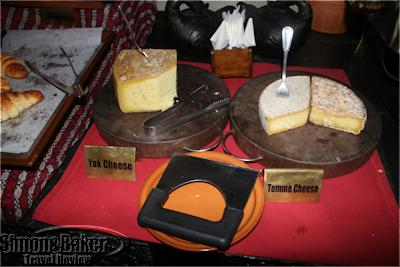
There were Nepali cheeses at breakfast
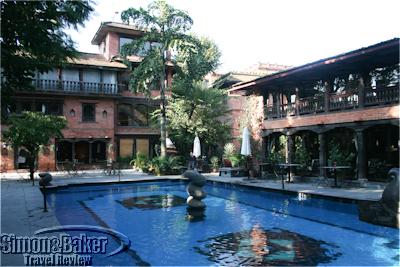
The Dwarika’s pool was adjacent to one of the restaurants
One night during my stay I had dinner at Krishnarpan, the hotel’s gourmet Nepali restaurant. After removing my shoes at the entrance of the restaurant there was a brief ceremonial “hand washing” before I was escorted across the wood floor to a ground level table. The candlelit room was decorated in wood and red tones. Prettily dressed staff ladies who spoke some English looked after guests.
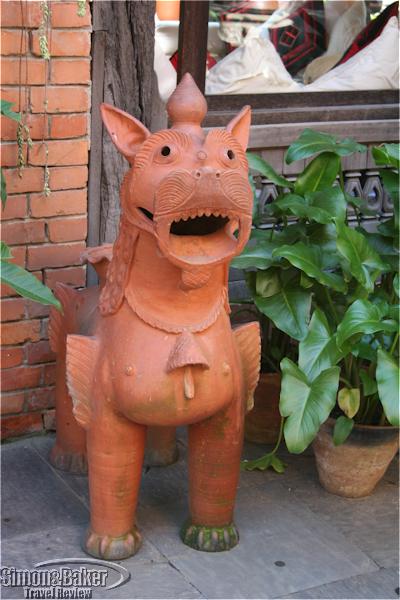
A sentinel in the common areas
It was necessary when booking my reservation with the front desk to decide which of the set menus I would have for dinner. While I was eager to sample Nepali dishes I chose the most modest, the six course dinner, on the staff’s recommendation. It consisted of: Samaya Bajee, an assortment of Nepali hors d’oeuvres served during religious ceremonies; Chyau Ko Sekuwa, Pan grilled oyster mushroom finished with fresh cream (a favorite); Roti, Unleavened griddle roasted bread; Momo, Potatoes and chickpeas cooked with Nepalese spices; Tarkari Ko Jhol, Vegetable soup cooked with Nepali spices (a favorite); Sada Bhuja, Organic steamed rice; Dal Jhaneko, Organic lentil tempered with Himalayan herbs; Kukhura Ko Masu, Traditional Nepali chicken curry cooked with aromatic Nepalese herbs and spices; Saag Jhaneko, Sauteed organic spinach with Nepalese spices; Aloo Ra Parwal Tareko, Stir fried potato and mini gourd; Eskush Ra Bhatamas Ko Tarkari, Sweet gourd and soyabean cooked with Nepali spices; Mis Mas Achar, Homemade vegetable pickle; Lapsee Ko Achaar, a very spicy Homemade hug-plum pickle; Sikarni, Fresh yoghurt flavored with cinnamon sweetened with honey; and Chiya wa Kafi, tea or coffee. Although almost all of the dishes were spicy and hot it was a most enjoyable meal served by attentive staff in an attractive dining room.

A special area was dedicated to the founder of the hotel
Named for Dwarika Das Shrestha, its founder, Dwarika’s Hotel in Kathmandu was outstanding for its combination of luxury features and facilities including a spa, heritage design, well appointed rooms, service and foodie oriented offerings. As I traveled around Nepal I realized how special Dwarika’s was and missed it.
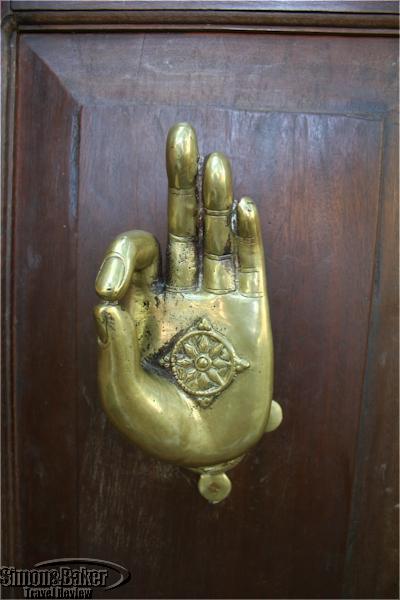
One of the many decorative touches
In addition to the architectural and artistic design features, including original thirteenth century artifacts and replicas, which lent the urban hotel a historic and cultural air I enjoyed Dwarika’s for the understated casual luxury, safety features and delicious food. Should I find myself in Kathmandu again this would be my first option for accommodations. Dwarika’s Hotel, P.O. Box P.O.Box-459, Battisputali, Kathmandu, Nepal, + 977-1 4479488/ 4470770, fax + 977-1 4471379/4478378, http://dwarikas.com, info@dwarikas.com
by Editor | Mar 12, 2012 | Attractions, Luxury Travel, Restaurants
Article by Laura Scheiber
Photos by Matthew Harris
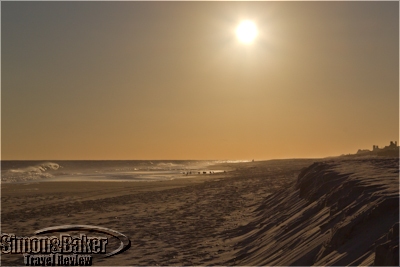
Coopers Beach, Southampton
When I moved to New York City years ago, a friend advised me that the only way to survive the City’s hectic lifestyle was to get out once a month. I couldn’t agree more. A weekend in Southampton, New York, was the perfect combination of a tranquil and easy getaway in an upscale setting with natural beauty and interesting local history. Because we went in the fall, we were able to enjoy the many delights of this famous retreat for the rich and famous, without the notorious summertime crowds.
Located on the southeastern end of Long Island, New York, Southampton is one of a number of prestigious villages collectively known as the Hamptons. The village was the first English settlement in the state of New York, dating all the way back to 1640; and as I soon learned, one of its most charming attributes was its rich history.

Bruce Michael, our enthusiastic tour guide
We arrived Friday evening after a two and half hour train ride from Penn Station, New York. The next day was a beautiful sunny but blustery fall day, and we were excited to discover the many treasures of this exclusive village. We met Bruce Michael, a local resident and tour guide, who led us on a fascinating historical journey of Southampton (Bruce Michael Guided Tours, 327 Central Park West Apt 2C, New York, NY 10025, +1 917 623 6602, http://www.discoverlongisland.com/visitors/more-info.aspx?cli_number=6727&major=, BruceMK@aol.com). What we liked about Bruce Michael as a tour guide was his genuine enthusiasm for the area, as well as the historical insight he provided about the high society families that have resided in Southampton over the last two centuries. We started in the center of town on Jobs Lane, a picturesque tree-shaded street lined with upscale boutiques.

The Parrish Art Museum
Our first stop was the Parrish Art Museum (25 Jobs Lane, Southampton, NY 11968, +1 631 283 2118, fax +1 631 283 7006, http://parrishart.org/, info@parrishart.org). Founded in 1897 by Samuel Longstreth Parrish, a discerning art collector, the museum has since housed a permanent collection of over 2,600 pieces by prominent artists who have lived or worked in the area, including Jackson Pollock, Roy Lichtenstein, William Merritt Chase and Fairfield Porter. Select works were displayed throughout the year in the museum’s changing exhibitions.
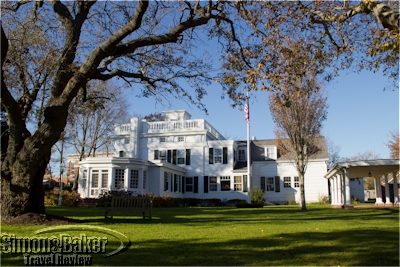
Rogers Mansion, headquarters of the Southampton Historical Museums and Research Center
After leaving the Parrish Art Museum, we walked up the street to a beautifully preserved Greek revival style home called Rogers Mansion, the headquarters of the Southampton Historical Museums and Research Center (17 Meeting House Lane, Southampton, NY 11969, +1 631 283 2494, fax +1 631 283 4540, www.southamptonhistoricalmuseum.org, info@southamptonhistoricalmuseum.org). We explored a handful of period rooms decorated in original furnishings, paintings and books of the home, originally built in 1843 for a wealthy whaling captain. I was particularly moved by the display of photos and newspaper articles describing the 1938 New England hurricane that devastated the area and was responsible for over 600 deaths in Long Island and southern New England. Just behind the mansion was the Old Southampton Village, made up of historic structures, such as a blacksmith’s shop, a paint shop and a colonial-era barn.
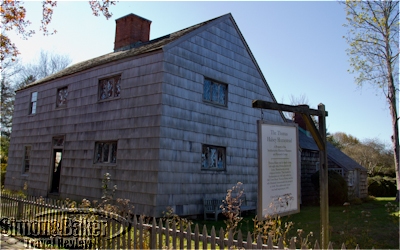
The Thomas Halsey Homestead
Next, we hopped in a van and visited the Thomas Halsey Homestead, just outside of the center of town (249 South Main Street, Southampton, NY 11969, +1 631 283 2494, fax +1 631 283 4540, http://southamptonhistoricalmuseum.org/museummain.asp?id=3). Built circa 1660, it is believed to be the oldest English-style house in New York State. We walked through the carefully curated rooms filled with original 17th and 18th century artifacts, such as open hearth cooking tools, a spinning wheel, and religious propaganda aimed at converting Native Americans.
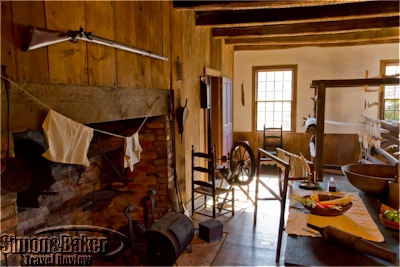
The Thomas Halsey Homestead, living standards have changed a lot since 1660
The final stop on our tour was Coopers Beach, a beautifully manicured sandy white beach, roughly 1.8 miles from the center of town. The pristine beach was virtually empty, which made for a tranquil setting. Simply breathing in the fresh seaside air while watching waves crash along the seashore had a calming effect on me.
Heading back to the center of town, we drove down a grid of well-groomed streets lined with palatial mansions. Manors surrounding Lake Agawam had bragging rights to some of the most expensive real estate in the United States, and served as summer homes to some of America’s most prestigious families. The two-hour historical tour served as an excellent introduction to some of the village’s most important historical sites and captured my imagination of earlier times in Southampton.

The Driver’s Seat Restaurant
After the tour we enjoyed lunch at the Driver’s Seat Restaurant (66 Jobs Lane, Southampton, NY 11968, +1 631 283 6606, fax +1 631 283 6607, http://www.thedriversseatrestaurant.com/The_Drivers_Seat_Restaurant/Home.html, driversseatrestaurant@gmail.com). The ambiance was a pleasant mix of laid back pub with upscale touches, including a fresh bouquet of roses on every table and white-linen table clothes. We had a friendly chat with the owner, who made us feel welcome. The food was tasty and satisfying. I appreciated the varied and reasonably priced menu, particularly in comparison to some of the other overpriced establishments we visited throughout the weekend.

Jobs Lane in the center of Southampton, home to elegant boutiques
We spent the rest of the afternoon casually strolling down Main Street and Jobs Lane, popping in and out of the many exclusive shops and boutiques. I liked that the diverse clothing stores, antiques, and high-end furniture and jewelry stores were within walking distance, making Southampton an elite shopper’s delight. Above and beyond shopping, the well-preserved historic architecture gave the area a colonial feel, added to its overall charm and made walking around the town center particularly pleasant.
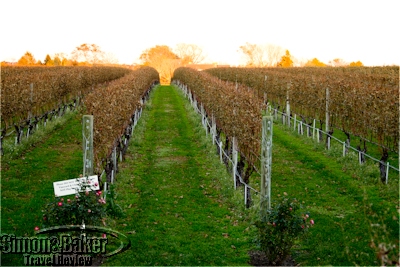
Wolffer Estate Vineyard
Just before sunset, we took a 15-minute car ride to Wolffer Estate Vineyard (139 Sagg Road, PO Box 9002, Sagaponack, NY 11962, +1 631 537 5106, fax +1 631 537 5107, www.wolffer.com, info@wolffer.com). The Tuscan-style villa looked out onto 55 acres of beautifully landscaped vineyards. I felt as if we had been transported to a European winery somewhere in the countryside. Wolffer Estate offered tastings ranging in price from $12 to $18 for four distinct wines. Our tasting began with the 2010 Grandioso Rose, followed by the 2007 Sparkling Brut, Blanc de Blanc, the 2008 Perle Chardonnay, and the 2008 Caya Cabernet Franc. Each of the wines had a distinct and appealing flavor. I jotted down their names so I could ask my local wine shop to order the ones I had sampled. Upon leaving the vineyard, I could not resist purchasing a bottle of the 2008 Perle Chardonnay as a reminder of our pleasant visit to Wolffer Estate.
One of the perks of our weekend getaway was its close proximity to New York City and convenient transportation options. Because we did not want to rent a car, we took the Long Island Rail Road departing from Penn Station in New York City, a two and a half hour relaxed journey. Cabs were waiting for us on our arrival at the train station of Southampton. Hometown Taxi charged $10 for my travel partner and I to go to the center of town five minutes away (425 County Road 39A, Southampton, NY 11968, +1 631 287 5200).
By the end of the weekend, I felt refreshed and ready to return to the faster-paced lifestyle of New York City. Overall we had a delightful autumn weekend in Southampton. The hassle-free travel from New York City, and slow-paced setting of the upscale village with its rich history and diverse attractions provided a wonderful respite from the hustle and bustle of the city.
by Editor | Mar 5, 2012 | Attractions
Article and photos by Elena del Valle
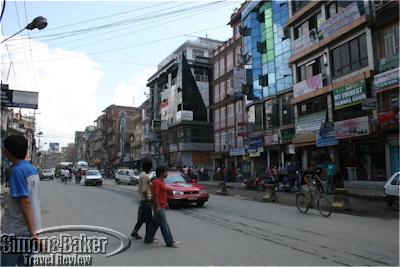
A street in Kathmandu
Sitting in the back seat of a taxi early on a holiday morning en route to the Kathmandu airport I was thankful that because of the festivities the often narrow roads, shared by a variety of vehicles and animals, of the usually congested and loud Nepali city were surprisingly empty. After passing through several security checks, presenting my ticket and paying taxes I reached a departure area filled with passengers, many waiting for sightseeing flights. Given how full the hall was it was surprising to think that only a week earlier a plane much as the one I was about to board and headed in the same direction had crashed on the side of a mountain with disastrous consequences.
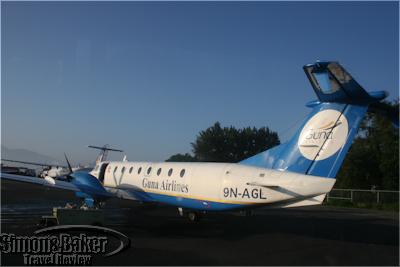
The Guna Airlines plane
Our flight was delayed. We patiently waited and watched others who had arrived behind us cross the final security point, women on one side and men on the other, to an awaiting bus. Eventually it became our turn. A bus delivered 16 of us to a Beech 1900 with Guna Airlines written on the side. We quickly boarded, each one adjacent to a window seat (the few seats without windows remained empty), and buckled up.
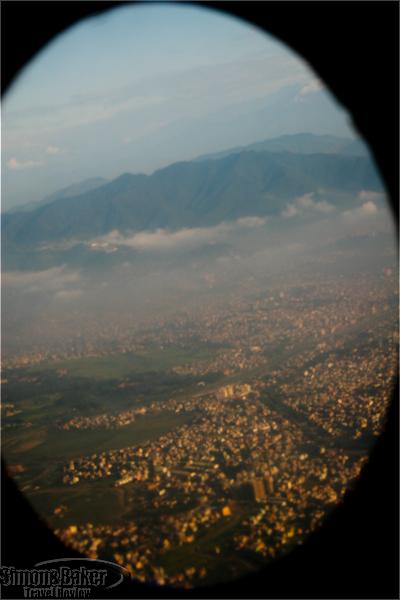
The Kathmandu Valley
Soon we were leaving the Kathmandu Valley behind us while heading toward the 8,848 meter (29,028 feet) tall Sagarmatha, as the locals know it, or Mount Everest for us, and the famous Himalayas. The day was sunny though a bit hazy and we were lucky, one of the staff explained, because the weather had been much less clear over the past few days.
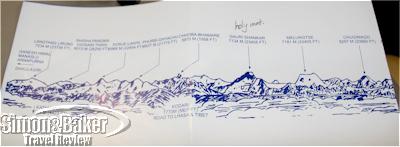
A handy chart of the Himalayan peaks was provided
As we approached the Himalayas it was difficult to distinguish which was which never mind which was the highest mountain in spite of the detailed illustration of the mountains on the inside of our ticket and hard-to-understand explanations over the plane’s speaker system. The flight crew invited us to walk up the narrow isle one by one to the cockpit for a brief glimpse and photo of the peaks on the horizon.
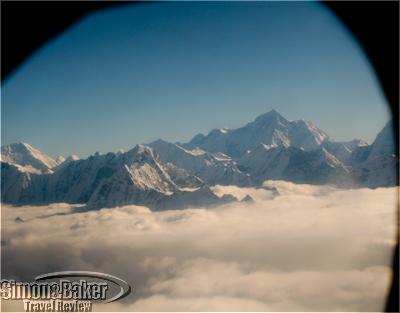
A stunning view of the highest mountains in the world
We did this twice with everyone staring in a mixture of what appeared to be surprise and awe and taking photos with all manner of photographic gear through the aircraft’s small and scratched windows. Too soon it was time to return. That brief $179 flight to the Himalayas, I realized later as I headed back to my hotel in the same taxi, had made my trip to Nepal worth all the countless hours of discomfort, flying and changing planes.






































